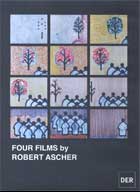
Four Films by Robert Ascher 1986 - 1995
Distributed by Documentary Educational Resources, 101 Morse Street, Watertown, MA 02472; 617-926-0491
Produced by Robert Ascher
Directed by Robert Ascher
DVD, color, 21 min.
Jr. High - General Adult
Anthropology, Films, Indigenous Peoples, Religion, Mythology
Date Entered: 06/26/2014
Reviewed by Kim Stanton, University of North Texas LibrariesThis collection of short films provides an introduction to the work of anthropologist and experimental filmmaker Robert Ascher. The films in this collection are representative of Asher’s style of filmmaking in which he uses animation to depict the mythologies of native or ancient cultures.
Ascher’s style can be considered an offshoot of ethnofiction, a type of filmmaking that combines elements of documentary and fiction within the context of visual anthropology. The origins of ethnofiction are linked to famed and prolific filmmaker Jean Rouch who in the 1950’s began actively injecting the cameraman and often times actors into the storyline of his ethnographic films. By the 1980’s, when Ascher began producing films, the use of real and unreal elements had expanded to include more experimental content. Ascher was of the school of thought that believed that sending a Western film crew into a non-Western culture could only result in a misreading of that culture. Finding this highly problematic, Ascher sought other methods of visual storytelling that he felt were more ethical and turned to a style of filmmaking commonly referred to as cameraless animation in which the filmmaker draws directly onto the celluloid.
The films in this collection cover myths from a variety of cultures. Bar Yohai and The Golem are both stories stemming from Jewish folklore, while Cycle (Australia) and Blue (Alaska) tell traditional tales of aboriginal tribes. A common thread in all four films is the visual and auditory style. The animation is a somewhat crude, but painterly and colorful style that often uses symbols and simple line drawing to enact the story. Bar Yohai is unique in its inclusion of photographs. The sound is either narration or song and is always in the native tongue of the culture, though English titles and credits are used throughout. Some aspects of this style will engage the viewer in questioning how possible it is to completely eliminate the Western gaze from ethnographic filmmaking.
This film is highly recommended for higher education institutions with visual anthropology and documentary film programs. It is also recommended for general collections that support anthropology, film studies, philosophy, religious studies and traditional storytelling.